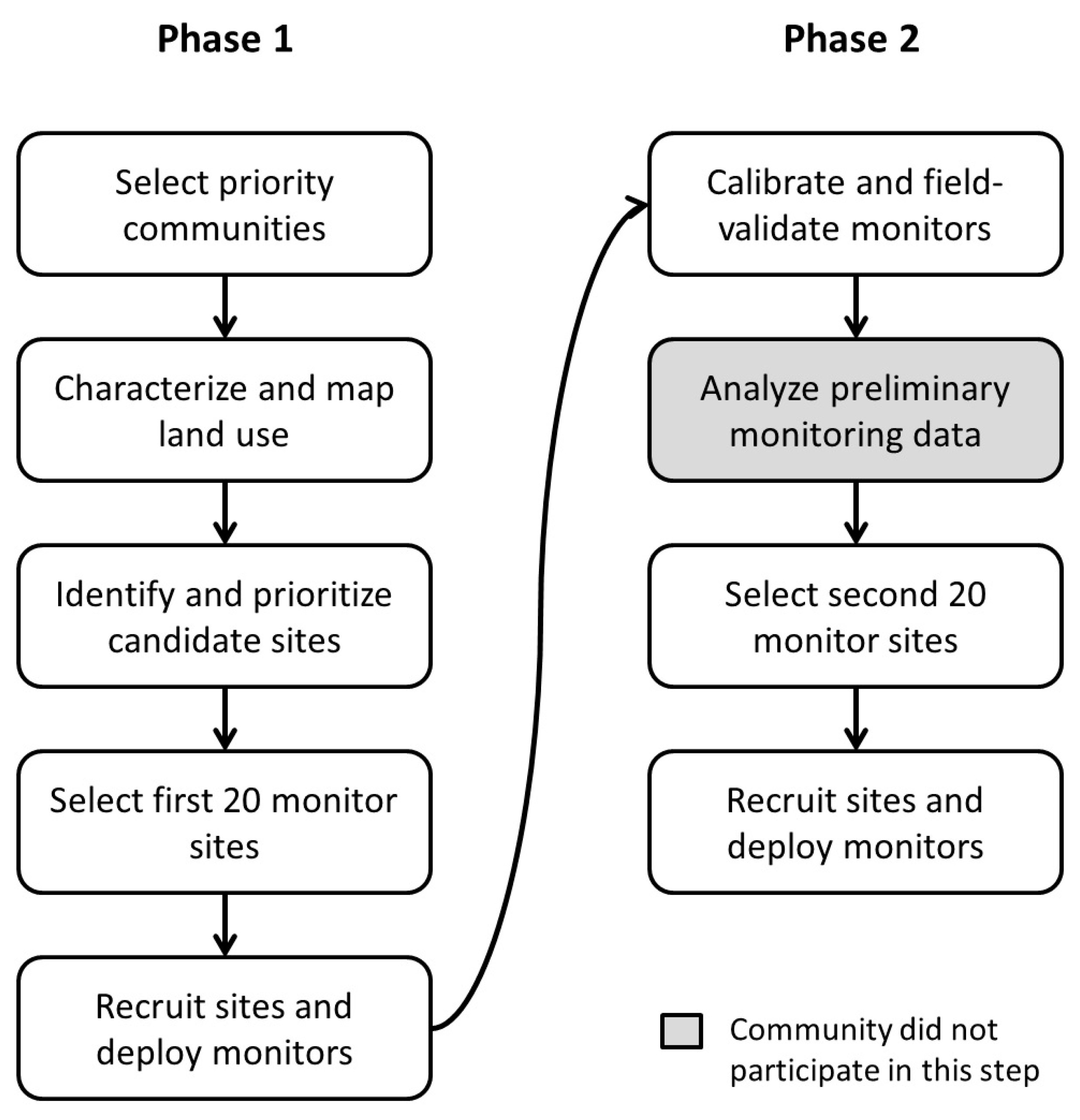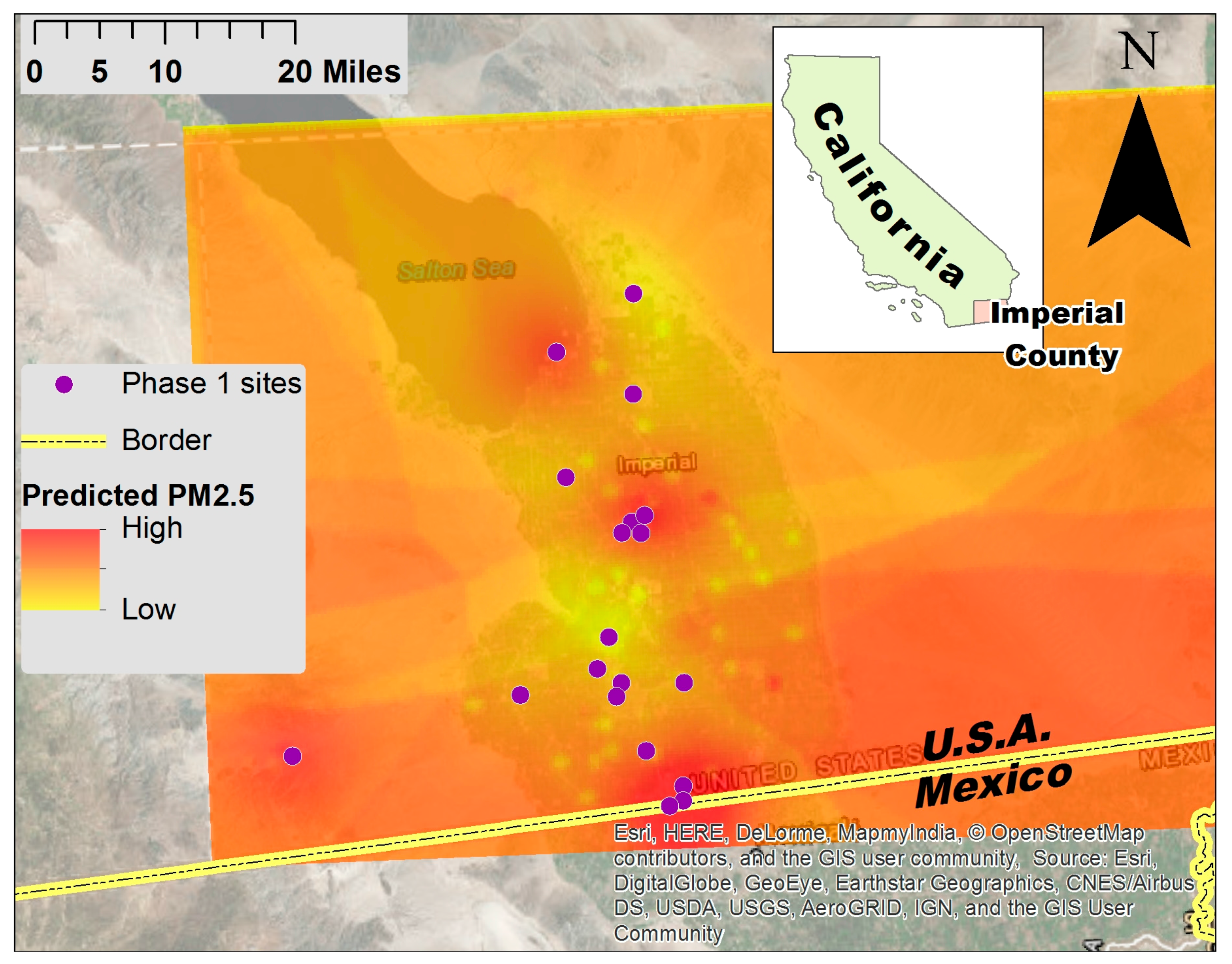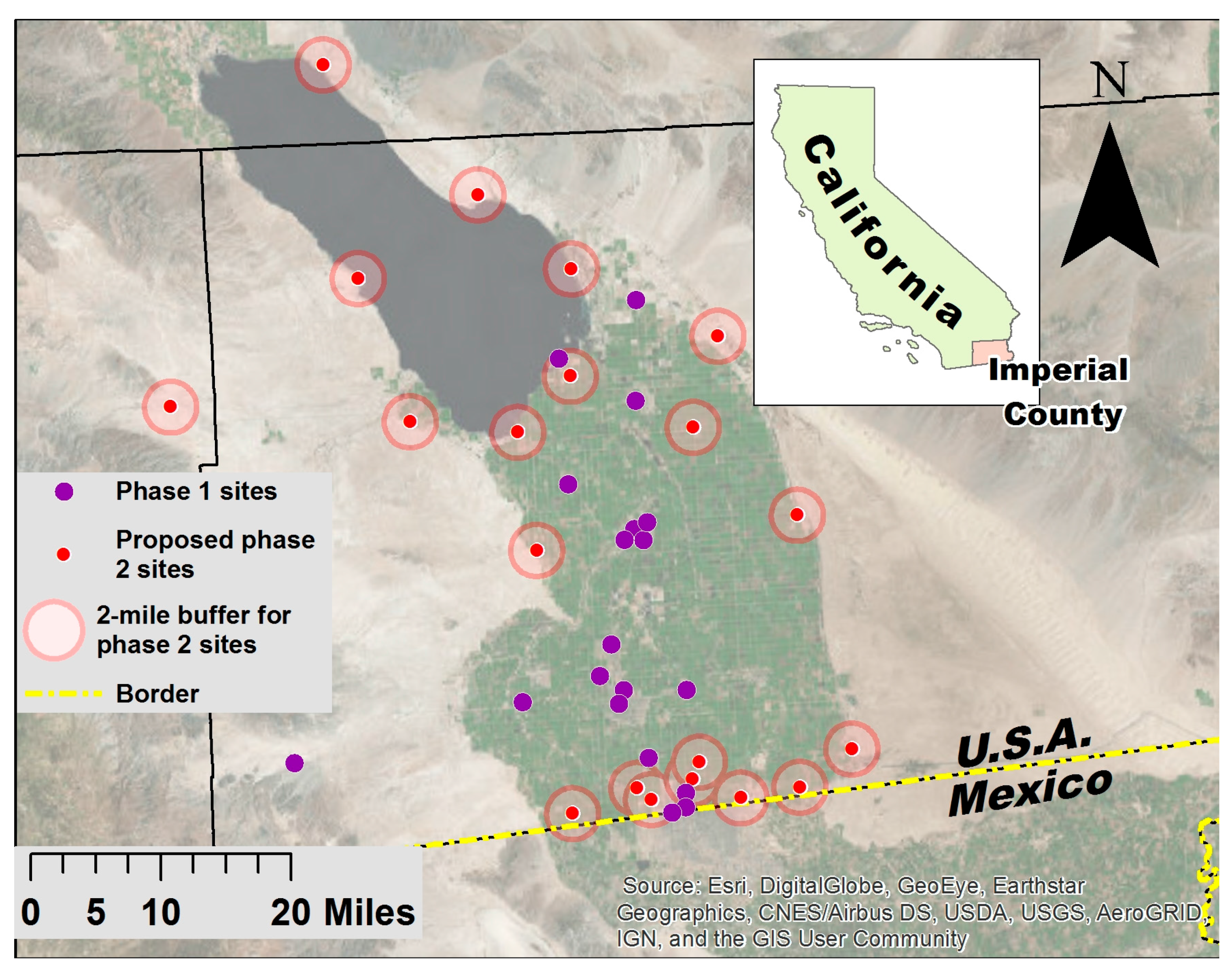Combining Community Engagement and Scientific Approaches in Next-Generation Monitor Siting: The Case of the Imperial County Community Air Network
Abstract
:1. Introduction
The Imperial County Community Air Monitoring Project
2. Materials and Methods
2.1. Community Engagement Structure
2.2. Deployment of Monitors in Stages
2.3. Phase 1: Community Process to Select the First Set of Monitoring Sites
2.4. Phase 2: Selection of Monitoring Sites Based on Data Analysis
3. Results
3.1. Sites Selected through the Phase 1 Community Process
3.2. Calibration and Validation
3.3. Sites Selected Based on Phase 2 Spatial Analysis
3.4. Completed Network Provides New, Locally-Relevant Information
3.5. Initial Response to the Community Air Monitoring Network
4. Discussion
5. Conclusions
Acknowledgments
Author Contributions
Conflicts of Interest
References
- World Health Organization. Burden of Disease from Ambient Air Pollution for 2012. Available online: http://www.who.int/phe/health_topics/outdoorair/databases/FINAL_HAP_AAP_BoD_24March2014.pdf (accessed on 1 November 2017).
- Vaduganathan, M.; De Palma, G.; Manerba, A.; Goldoni, M.; Triggiani, M.; Apostoli, P.; Dei Cas, L.; Nodari, S. Risk of Cardiovascular Hospitalizations from Exposure to Coarse Particulate Matter (PM10) Below the European Union Safety Threshold. Am. J. Cardiol. 2016, 117, 1231–1235. [Google Scholar] [CrossRef] [PubMed]
- Di, Q.; Wang, Y.; Zanobetti, A.; Wang, Y.; Koutrakis, P.; Choirat, C.; Dominici, F.; Schwartz, J.D. Air Pollution and Mortality in the Medicare Population. N. Engl. J. Med. 2017, 376, 2513–2522. [Google Scholar] [CrossRef] [PubMed]
- Araki, S.; Yamamoto, K.; Kondo, A. Application of Regression Kriging to Air Pollutant Concentrations in Japan with High Spatial Resolution. Aerosol. Air Qual. Res. 2015, 15, 234–241. [Google Scholar] [CrossRef]
- Sicard, P.; Serra, R.; Rossello, P. Spatiotemporal trends in ground-level ozone concentrations and metrics in France over the time period 1999–2012. Environ. Res. 2016, 149, 122–144. [Google Scholar] [CrossRef] [PubMed]
- Snyder, E.G.; Watkins, T.H.; Solomon, P.A.; Thoma, E.D.; Williams, R.W.; Hagler, G.S.; Shelow, D.; Hindin, D.A.; Kilaru, V.J.; Preuss, P.W. The Changing Paradigm of Air Pollution Monitoring. Environ. Sci. Technol. 2013, 47, 11369–11377. [Google Scholar] [CrossRef] [PubMed]
- Cheng, Y.; Li, X.; Li, Z.; Jiang, S.; Li, Y.; Jia, J.; Jiang, X. AirCloud: A cloud-based air-quality monitoring system for everyone. In Proceedings of the 12th ACM Conference on Embedded Network Sensor Systems, Memphis, TN, USA, 3–6 November 2014; pp. 251–265. [Google Scholar]
- Sivaraman, V.; Carrapetta, J.; Hu, K.; Luxan, B.G. HazeWatch: A participatory sensor system for monitoring air pollution in Sydney. In Proceedings of the 2013 IEEE 38th Conference on Local Computer Networks Workshops (LCN Workshops), Sydney, Australia, 21–24 October 2013; pp. 56–64. [Google Scholar]
- Israel, B.A.; Schulz, A.J.; Parker, E.A.; Becker, A.B. Review of community-based research: Assessing partnership approaches to improve public health. Annu. Rev. Public Health 1998, 190, 173–202. [Google Scholar] [CrossRef] [PubMed]
- O’Rourke, D.; Macey, G.P. Community environmental policing: Assessing new strategies of public participation in environmental regulation. J. Policy Anal. Manag. 2003, 22, 383–414. [Google Scholar] [CrossRef]
- Ottinger, G. Buckets of resistance: Standards and the effectiveness of citizen science. Sci. Technol. Hum. Values 2010, 35, 244–270. [Google Scholar] [CrossRef]
- Minkler, M.; Garcia, A.P.; Williams, J.; LoPresti, T.; Lilly, J. Si se puede: Using participatory research to promote environmental justice in a Latino community in San Diego, California. J. Urban Health 2010, 87, 796–812. [Google Scholar] [CrossRef] [PubMed]
- Conrad, C.C.; Hilchey, K.G. A Review of Citizen Science and Community-Based Environmental Monitoring: Issues and Opportunities. Environ. Monit. Assess. 2011, 176, 273–291. [Google Scholar] [CrossRef] [PubMed]
- Briggs, D.J.; Collins, S.; Elliott, P.; Fischer, P.; Kingham, S.; Lebret, E.; Pryl, K.; van Reeuwijk, H.; Smallbone, K.; Van Der Veen, A. Mapping urban air pollution using GIS: A regression-based approach. Int. J. Geogr. Inf. Sci. 1997, 11, 699–718. [Google Scholar] [CrossRef]
- United States Census Bureau. QuickFacts, Imperial County, California. Available online: https://www.census.gov/quickfacts/fact/table/imperialcountycalifornia/PST045216 (accessed on 24 October 2017).
- California Air Resources Board. Trends Summary. Available online: http://www.arb.ca.gov/adam/trends/trends1.php (accessed on 13 February 2017).
- California Air Resources Board. Imperial County 2013 State Implementation Plan for the Federal PM2.5 Standard. Available online: https://www.arb.ca.gov/board/books/2014/121814/14-10-2pres.pdf (accessed on 20 June 2017).
- United States Department of Transportation, Bureau of Transportation Statistics. Border Crossing/Entry Data. Available online: https://transborder.bts.gov/programs/international/transborder/TBDR_BC/TBDR_BCQ.html (accessed on 24 April 2017).
- Imperial County Air Pollution Control District. Available online: http://www.co.imperial.ca.us/AirPollution (accessed on 24 October 2017).
- Pacific Institute. Hazard’s Toll: The Costs of Inaction at the Salton Sea. Available online: http://pacinst.org/app/uploads/2014/09/PacInst_HazardsToll_low-res.pdf (accessed on 6 July 2017).
- Anderson, J.O.; Thundiyil, J.G.; Stolbach, A. Clearing the Air: A Review of the Effects of Particulate Matter Air Pollution on Human Health. J. Med. Toxicol. 2012, 8, 166–175. [Google Scholar] [CrossRef] [PubMed]
- Luo, C.; Zhu, X.; Yao, C.; Hou, L.; Zhang, J.; Cao, J.; Wang, A. Short-term exposure to particulate air pollution and risk of myocardial infarction: A systematic review and meta-analysis. Environ. Sci. Pollut. Res. 2015, 22, 14651–14662. [Google Scholar] [CrossRef] [PubMed]
- Martinelli, N.; Olivieri, O.; Girelli, D. Air particulate matter and cardiovascular disease: A narrative review. Eur. J. Int. Med. 2013, 24, 295–302. [Google Scholar] [CrossRef] [PubMed]
- California Environmental Health Tracking Program. Asthma Data Query. Available online: http://cehtp.org/page/asthma/query (accessed on 13 February 2017).
- California Environmental Health Tracking Program. Heart Attacks Data Query. Available online: http://cehtp.org/page/mi/query (accessed on 13 February 2017).
- English, P.B.; Olmedo, L.; Bejarano, E.; Lugo, H.; Murillo, E.; Seto, E.; Wong, M.; King, G.; Wilkie, A.; Meltzer, D. The Imperial County Community Air Monitoring Network: A Model for Community-Based Environmental Monitoring for Public Health Action. Environ. Health Perspect 2017, 125, 074501. [Google Scholar] [CrossRef] [PubMed]
- IVAN (Identifying Violations Affecting Neighborhoods) Imperial. Available online: https://ivan-imperial.org (accessed on 18 March 2018).
- Carvlin, G.N.; Lugo, H.; Olmedo, L.; Bejarano, E.; Wilkie, A.; Meltzer, D.; Wong, M.; King, G.; Northcross, A.; Jerrett, M.; et al. Development and field validation of a community-engaged particulate matter air quality monitoring network in Imperial, California, USA. J. Air Waste Manag. Assoc. 2017, 67, 1342–1352. [Google Scholar] [CrossRef] [PubMed]
- IVAN Imperial AIR. Map of Monitors. Available online: https://ivan-imperial.org/air/map (accessed on 20 December 2017).
- California Air Resources Board. Imperial Valley Air Quality. Available online: http://www.imperialvalleyair.org (accessed on 20 December 2017).
- United States Environmental Protection Agency. EPA’s Next Generation Air Measuring Research. Available online: https://www.epa.gov/sciencematters/epas-next-generation-air-measuring-research (accessed on 1 November 2017).
- California Air Resources Board. ARB’s Perspective on Next Generation Air Monitoring Technology. Available online: http://www.baaqmd.gov/~/media/files/communications-and-outreach/community-outreach/events/michael-benjamin-capcoa-air-sensors-workshop.pdf (accessed on 1 November 2017).
- South Coast Air Quality Management District. Air Quality Sensor Performance Evaluation Center. Available online: http://www.aqmd.gov/aq-spec/home (accessed on 1 November 2017).
- California Legislative Information. AB-617 Nonvehicular Air Pollution: Criteria Air Pollutants and Toxic Air Contaminants (2017–2018). Available online: http://leginfo.legislature.ca.gov/faces/billTextClient.xhtml?bill_id=201720180AB617 (accessed on 1 November 2017).
- California State Assembly Joint Legislative Committee on Climate Change Policies. Informational Hearing: Air Quality in California’s Border Region. Available online: http://climatechangepolicies.legislature.ca.gov/sites/climatechangepolicies.legislature.ca.gov/files/Background%20Sheet%20-%20AQ%2011.3.2017%20-%20REVISED.pdf (accessed on 1 November 2017).
- California Air Resources Board. Update on AB 617 Community Air Protection Program. Available online: https://www.arb.ca.gov/board/books/2017/102617/17-10-5pres.pdf (accessed on 1 November 2017).





© 2018 by the authors. Licensee MDPI, Basel, Switzerland. This article is an open access article distributed under the terms and conditions of the Creative Commons Attribution (CC BY) license (http://creativecommons.org/licenses/by/4.0/).
Share and Cite
Wong, M.; Bejarano, E.; Carvlin, G.; Fellows, K.; King, G.; Lugo, H.; Jerrett, M.; Meltzer, D.; Northcross, A.; Olmedo, L.; et al. Combining Community Engagement and Scientific Approaches in Next-Generation Monitor Siting: The Case of the Imperial County Community Air Network. Int. J. Environ. Res. Public Health 2018, 15, 523. https://doi.org/10.3390/ijerph15030523
Wong M, Bejarano E, Carvlin G, Fellows K, King G, Lugo H, Jerrett M, Meltzer D, Northcross A, Olmedo L, et al. Combining Community Engagement and Scientific Approaches in Next-Generation Monitor Siting: The Case of the Imperial County Community Air Network. International Journal of Environmental Research and Public Health. 2018; 15(3):523. https://doi.org/10.3390/ijerph15030523
Chicago/Turabian StyleWong, Michelle, Esther Bejarano, Graeme Carvlin, Katie Fellows, Galatea King, Humberto Lugo, Michael Jerrett, Dan Meltzer, Amanda Northcross, Luis Olmedo, and et al. 2018. "Combining Community Engagement and Scientific Approaches in Next-Generation Monitor Siting: The Case of the Imperial County Community Air Network" International Journal of Environmental Research and Public Health 15, no. 3: 523. https://doi.org/10.3390/ijerph15030523





